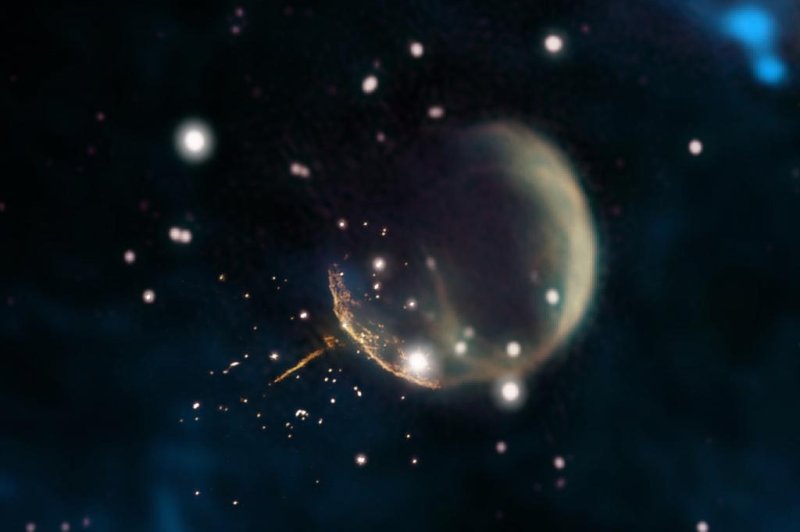The composite images reveals the bright jet-like tail of the high-speed pulsar, J0002. Photo by Jayanne English, University of Manitoba, using data from NRAO/F. Schinzel et al., DRAO/Canadian Galactic Plane Survey and NASA/IRAS
March 21 (UPI) -- Astronomers have discovered a pulsar traveling at unprecedented speeds. Observations by NASA's Fermi Gamma-ray Space Telescope suggest the star is moving through space at 2.5 million miles per hour.
Pulsars are extremely dense neutron stars that spin rapidly, producing a pulsing jet. The pulsing radio-emitting jet, or tail, points toward the remnants of a recent supernova explosion.
"Thanks to its narrow dart-like tail and a fortuitous viewing angle, we can trace this pulsar straight back to its birthplace," Frank Schinzel, a scientist at the National Radio Astronomy Observatory in New Mexico, told NASA. "Further study of this object will help us better understand how these explosions are able to 'kick' neutron stars to such high speed."
Pulsars are named so because the star's spinning electromagnetic field shoots out pulses of energy in the form of radio waves, visible light, X-rays and gamma rays. Astronomers searching for pulsars look for the pulsing signals among telescope observations.
This particular pulsar was discovered by citizen scientists scanning Femi data. Participants in the Einstein@Home project have identified 13 gamma ray pulsars.
Scientists named the high-speed pulsing star PSR J0002+6216, or J0002 for short. The star is located in the Cassiopeia constellation, 6,500 light-years from Earth.
Astronomers were able to survey archival Fermi data and track J0002's changing position, calculating its tremendous speed.
"The longer the data set, the more powerful the pulsar timing technique is," said Matthew Kerr, a scientist at the U.S. Naval Research Laboratory in Washington. "Fermi's lovely 10-year data set is essentially what made this measurement possible."
Analysis of the pulsar's trajectory and pulsing tail suggest the spinning neutron star was ejected by a supernova named CTB 1. Scientists estimated J0002 was expelled from CTB 1 approximately 10,000 years ago.
Scientists aren't totally sure how J0002 accelerated to such tremendous speeds. In the wake of the supernova explosion from which the pulsar originated, expelled gas and dust from the exploded companion star likely outraced J0002.
Eventually, the shell of stellar shrapnel was slowed by interactions with interstellar gas, but astronomers theorize that some of stellar debris may have coalesced into a region of dense matter, forming a "gravitational tugboat" that is pulling J0002 through space.















